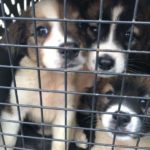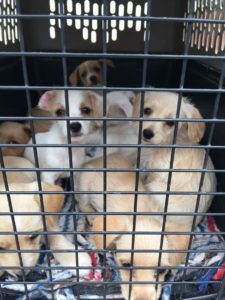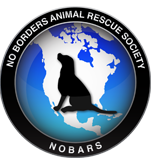Newsletter Vol. 1
Newsletter Volume 1
Monday Morning Nutrition
Introducing our Monday Morning Nutrition
No Borders Animal Rescue Society (NOBARS) is pleased to present our new series on pet nutrition. We are also pleased to announce Frances Parker, Centralized Adoption Facilitator And Karen Evans, Centralized Foster Facilitator.
7 Tips for Fear-Free Dog Nail Trims
7 Tips for Fear-Free Dog Nail Trims
Dog nail trims are one of the most frequently requested procedures veterinarians are asked to do. Why? Many pet owners know that proper nail care is important, but it can also be fear-inducing for the dog and for the human who is holding the clippers. Can you relate? The last thing you want to do is cause your best furry friend pain. Or maybe your dog has had a nail trimming experience that went awry and it’s holding you back from tackling the nail trim. Or may you’re not quite sure how to start.
The First 30 Days
The First 30 Days
The first few days in your home are special and critical for a pet. Your new dog will be confused about where he is and what to expect from you. Setting up some clear structure with your family for your dog will be paramount in making as smooth a transition as possible.
Before You Bring Your Dog Home:
Determine where your dog will be spending most of his time. Because he will be under a lot of stress with the change of environment (from shelter or foster home to your house), he may forget any housebreaking (if any) he’s learned. Often a kitchen will work best for easy clean-up.
- If you plan on crate training your dog, be sure to have a crate set-up and ready to go for when you bring your new dog home.
- Dog-proof the area where your pooch will spend most of his time during the first few months. This may mean taping loose electrical cords to baseboards; storing household chemicals on high shelves; removing plants, rugs, and breakables; setting up the crate, and installing baby gates.
- Training your dog will start the first moment you have him. Take time to create a vocabulary list everyone will use when giving your dog directions. This will help prevent confusion and help your dog learn his commands more quickly
- Bring an ID tag with your phone number on it with you when you pick up your dog so that he has an extra measure of safety for the ride home and the first few uneasy days.
- FIRST NIGHT TRIP HOME DO’S AND DON’T’S – Take into consideration that the dog just arrived from a long journey in the crate. He will also be sedated and will need time to come off Sedation
- Do… bring a leash, a blanket and some yummy treats for first introductions, especially if picking up at the airport. Remember to put your phone number inside the collar until you have a proper tag.
- DO…plan the trip home from the airport, are you alone or is someone with you who can secure the dog? Do you need a crate or harness to secure him?
- DO…go for a slow and relaxed 15-minute walk with your dog in a quiet as possible area when you come home. If the dog will not pee or poo on this first occasion, he/she is probably still scared due to the new surroundings and somewhat sedated from the flight. If you have a fenced yard with no possibility to escape you can let her/him run and discover the yard off leash a bit, the chances for doing the business are much higher. If nothing happens, it will probably happen inside, so be prepared! Some Dogs tend not to relieve themselves when they are tense and scared, while others do exactly that.
- DO…. give the dog a safe place (bed, crate) and introduce him/her right away when you come home. This could be a left open crate with a blanket or a dog bed. Choose an area you can separate from the rest of the house if necessary but where you are not too far away and where you can clean up easily, as mentioned accidents are probable. Do not force the dog to go back into a crate as he might be apprehensive after the trip.
- DO… provide water right away. Do offer food right away, as he will not have eaten. Flying can make the dog nauseous and therefore they are not fed prior to flight.
- DON’T…let the dog off leash as long as in foster care or if not officially adopted (dog park and fenced, secured areas are ok), we would recommend if you adopt right away to also wait at least as long as you get a good recall. Please take advantage of our training to ensure you have the skills to help him.
First Day:
- We know moving is stressful — and your new dog feels the same way! Give him time to acclimate to your home and family before introducing him to strangers. Make sure children know how to approach the dog without overwhelming him.
- When you pick up your dog, remember to ask what and when he was fed. Replicate that schedule for at least the first few days to avoid gastric distress. If you wish to switch to a different brand, do so over a period of about a week by adding one part new food to three parts of the old for several days; then switch to half new food, half old, and then one part old to three parts new.
- On the way home, your dog should be safely secured, preferably in a crate. Some dogs find car trips stressful, so having him in a safe place will make the trip home easier on him and you.
- Once home, take him to his toileting area immediately and spend a good amount of time with him so he will get used to the area and relieve himself. Even if your dog does relieve himself during this time, be prepared for accidents. Coming into a new home with new people, new smells and new sounds will throw even the most housebroken dog off-track, so be ready just in case.
- If you plan on crate training your dog, leave the crate open so that he can go in whenever he feels like it in case he gets overwhelmed.
- From there, start your schedule of feeding, toileting, and play/exercise. From Day One, your dog will need family time and brief periods of solitary confinement. Don’t give in and comfort him if he whines when left alone. Instead, give him attention for good behavior, such as chewing on a toy or resting quietly.
Introduce your dog to all house rules right away and be consistent; otherwise the pup will become confused (eg ; if he/she is not allowed to jump on the couch except you invite him/her don’t let the dog up at all for at least a month, then you can invite your pup up if you wish) . You can start with the most important cue, the recall ’COME” in the house or in a fenced secure area as soon as you notice the dog trusts you and is starting to relax. The Spanish equivalent is “Ven” or “Ven Aqui”. Speak both to the dog at first until he understands the word “Come”. Be careful to not overwhelm with commands or expectations. If you see the dog is scared and/or uneasy, stop and encourage easy tasks like coming to you and reward with a treat. Give him/her the time they need. If the dog is totally settled in after 2 days, go ahead and start training, but no more than 2 commands at a time.
- For the first few days, remain calm and quiet around your dog, limiting too much excitement (such as the dog park or neighborhood children). Not only will this allow your dog to settle in easier, it will give you more one-on-one time to get to know him and his likes/dislikes.
- If he came from another home, objects like leashes, hands, rolled up newspapers and magazines, feet, chairs and sticks are just some of the pieces of “training equipment” that may have been used on this dog. Words like “come here” and “lie down” may bring forth a reaction other than the one you expect. Or maybe he led a sheltered life and was never socialized to children or sidewalk activity. This dog may be the product of a never-ending series of scrambled communications and unreal expectations that will require patience on your part.
Following Weeks:
- People often say they don’t see their dog’s true personality until several weeks after adoption. Your dog will be a bit uneasy at first as he gets to know you. Be patient and understanding while also keeping to the schedule you intend to maintain for feeding, walks, etc. This schedule will show your dog what is expected of him as well as what he can expect from you.
- After discussing it with your veterinarian to ensure your dog has all the necessary vaccines, you may wish to take your dog to group training classes or the dog park. Pay close attention to your dog’s body language to be sure he’s having a good time — and is not fearful or a dog park bully.
- To have a long and happy life together with your dog, stick to the original schedule you created, ensuring your dog always has the food, potty time and attention he needs. You’ll be bonded in no time!
- If you encounter behavior issues you are unfamiliar with, speak with your NOBARS rep immediately, so that we can assist with finding a good trainer. We select a trainer who uses positive reinforcement techniques to help you and your dog overcome these behavior obstacles.
- Special considerations: Children and other pets
- CHILDREN
- DON’T… ever let a dog, especially a puppy alone with small children at any times.
- DON’T…let toys or food laying around while smaller children are around.
- DON’T…let a small child approach a sleeping dog, an eating dog.
- DON’T…play tug and war with your dog if you have a small child, this is a cause of many accidents.
- Should you have any concerns or feel uncomfortable with the situation between the dog and a child, don’t hesitate to contact NOBARS, we will immediately either take the dog out of your home or send a trainer to provide you with help. We are happy to provide you with more information if you have children. Please contact us.
OTHER PETS IN THE HOUSE
- DO… introduce your dog to the new furry friend outside of the house, meet up with the newcomer outside and go for a walk and slowly introduce them. Start by letting them see each other and then slowly get closer until they can sniff each other with contact. Once they have accepted each other, you can enter the house
- DON’T…leave your dog’s favorite toy and bone lying around
- DON’T… leave leftover food around. After feeding, collect the food bowls and put them away till next meal. If you notice some food aggression? Feed the dogs separate for the moment.

Congratulations!
If you follow these tips, you’ll be on your way to having a well-adjusted canine family member.
The First 30 Days
The first few days in your home are special and critical for a pet. Your new dog will be confused about where he is and what to expect from you. Setting up some clear structure with your family for your dog will be paramount in making as smooth a transition as possible.
Before You Bring Your Dog Home:
Determine where your dog will be spending most of his time. Because he will be under a lot of stress with the change of environment (from shelter or foster home to your house), he may forget any housebreaking (if any) he’s learned. Often a kitchen will work best for easy clean-up.
- If you plan on crate training your dog, be sure to have a crate set-up and ready to go for when you bring your new dog home.
- Dog-proof the area where your pooch will spend most of his time during the first few months. This may mean taping loose electrical cords to baseboards; storing household chemicals on high shelves; removing plants, rugs, and breakables; setting up the crate, and installing baby gates.
- Training your dog will start the first moment you have him. Take time to create a vocabulary list everyone will use when giving your dog directions. This will help prevent confusion and help your dog learn his commands more quickly
- Bring an ID tag with your phone number on it with you when you pick up your dog so that he has an extra measure of safety for the ride home and the first few uneasy days.
- FIRST NIGHT TRIP HOME DO’S AND DON’T’S – Take into consideration that the dog just arrived from a long journey in the crate. He will also be sedated and will need time to come off Sedation
- Do… bring a leash, a blanket and some yummy treats for first introductions, especially if picking up at the airport. Remember to put your phone number inside the collar until you have a proper tag.
- DO…plan the trip home from the airport, are you alone or is someone with you who can secure the dog? Do you need a crate or harness to secure him?
- DO…go for a slow and relaxed 15-minute walk with your dog in a quiet as possible area when you come home. If the dog will not pee or poo on this first occasion, he/she is probably still scared due to the new surroundings and somewhat sedated from the flight. If you have a fenced yard with no possibility to escape you can let her/him run and discover the yard off leash a bit, the chances for doing the business are much higher. If nothing happens, it will probably happen inside, so be prepared! Some Dogs tend not to relieve themselves when they are tense and scared, while others do exactly that.
- DO…. give the dog a safe place (bed, crate) and introduce him/her right away when you come home. This could be a left open crate with a blanket or a dog bed. Choose an area you can separate from the rest of the house if necessary but where you are not too far away and where you can clean up easily, as mentioned accidents are probable. Do not force the dog to go back into a crate as he might be apprehensive after the trip.
- DO… provide water right away. Do offer food right away, as he will not have eaten. Flying can make the dog nauseous and therefore they are not fed prior to flight.
- DON’T…let the dog off leash as long as in foster care or if not officially adopted (dog park and fenced, secured areas are ok), we would recommend if you adopt right away to also wait at least as long as you get a good recall. Please take advantage of our training to ensure you have the skills to help him.
First Day:
- We know moving is stressful — and your new dog feels the same way! Give him time to acclimate to your home and family before introducing him to strangers. Make sure children know how to approach the dog without overwhelming him.
- When you pick up your dog, remember to ask what and when he was fed. Replicate that schedule for at least the first few days to avoid gastric distress. If you wish to switch to a different brand, do so over a period of about a week by adding one part new food to three parts of the old for several days; then switch to half new food, half old, and then one part old to three parts new.
- On the way home, your dog should be safely secured, preferably in a crate. Some dogs find car trips stressful, so having him in a safe place will make the trip home easier on him and you.
- Once home, take him to his toileting area immediately and spend a good amount of time with him so he will get used to the area and relieve himself. Even if your dog does relieve himself during this time, be prepared for accidents. Coming into a new home with new people, new smells and new sounds will throw even the most housebroken dog off-track, so be ready just in case.
- If you plan on crate training your dog, leave the crate open so that he can go in whenever he feels like it in case he gets overwhelmed.
- From there, start your schedule of feeding, toileting, and play/exercise. From Day One, your dog will need family time and brief periods of solitary confinement. Don’t give in and comfort him if he whines when left alone. Instead, give him attention for good behavior, such as chewing on a toy or resting quietly.
Introduce your dog to all house rules right away and be consistent; otherwise the pup will become confused (eg ; if he/she is not allowed to jump on the couch except you invite him/her don’t let the dog up at all for at least a month, then you can invite your pup up if you wish) . You can start with the most important cue, the recall ’COME” in the house or in a fenced secure area as soon as you notice the dog trusts you and is starting to relax. The Spanish equivalent is “Ven” or “Ven Aqui”. Speak both to the dog at first until he understands the word “Come”. Be careful to not overwhelm with commands or expectations. If you see the dog is scared and/or uneasy, stop and encourage easy tasks like coming to you and reward with a treat. Give him/her the time they need. If the dog is totally settled in after 2 days, go ahead and start training, but no more than 2 commands at a time.
- For the first few days, remain calm and quiet around your dog, limiting too much excitement (such as the dog park or neighborhood children). Not only will this allow your dog to settle in easier, it will give you more one-on-one time to get to know him and his likes/dislikes.
- If he came from another home, objects like leashes, hands, rolled up newspapers and magazines, feet, chairs and sticks are just some of the pieces of “training equipment” that may have been used on this dog. Words like “come here” and “lie down” may bring forth a reaction other than the one you expect. Or maybe he led a sheltered life and was never socialized to children or sidewalk activity. This dog may be the product of a never-ending series of scrambled communications and unreal expectations that will require patience on your part.
Following Weeks:
- People often say they don’t see their dog’s true personality until several weeks after adoption. Your dog will be a bit uneasy at first as he gets to know you. Be patient and understanding while also keeping to the schedule you intend to maintain for feeding, walks, etc. This schedule will show your dog what is expected of him as well as what he can expect from you.
- After discussing it with your veterinarian to ensure your dog has all the necessary vaccines, you may wish to take your dog to group training classes or the dog park. Pay close attention to your dog’s body language to be sure he’s having a good time — and is not fearful or a dog park bully.
- To have a long and happy life together with your dog, stick to the original schedule you created, ensuring your dog always has the food, potty time and attention he needs. You’ll be bonded in no time!
- If you encounter behavior issues you are unfamiliar with, speak with your NOBARS rep immediately, so that we can assist with finding a good trainer. We select a trainer who uses positive reinforcement techniques to help you and your dog overcome these behavior obstacles.
- Special considerations: Children and other pets
- CHILDREN
- DON’T… ever let a dog, especially a puppy alone with small children at any times.
- DON’T…let toys or food laying around while smaller children are around.
- DON’T…let a small child approach a sleeping dog, an eating dog.
- DON’T…play tug and war with your dog if you have a small child, this is a cause of many accidents.
- Should you have any concerns or feel uncomfortable with the situation between the dog and a child, don’t hesitate to contact NOBARS, we will immediately either take the dog out of your home or send a trainer to provide you with help. We are happy to provide you with more information if you have children. Please contact us.
OTHER PETS IN THE HOUSE
- DO… introduce your dog to the new furry friend outside of the house, meet up with the newcomer outside and go for a walk and slowly introduce them. Start by letting them see each other and then slowly get closer until they can sniff each other with contact. Once they have accepted each other, you can enter the house
- DON’T…leave your dog’s favorite toy and bone lying around
- DON’T… leave leftover food around. After feeding, collect the food bowls and put them away till next meal. If you notice some food aggression? Feed the dogs separate for the moment.

Congratulations!
If you follow these tips, you’ll be on your way to having a well-adjusted canine family member.



